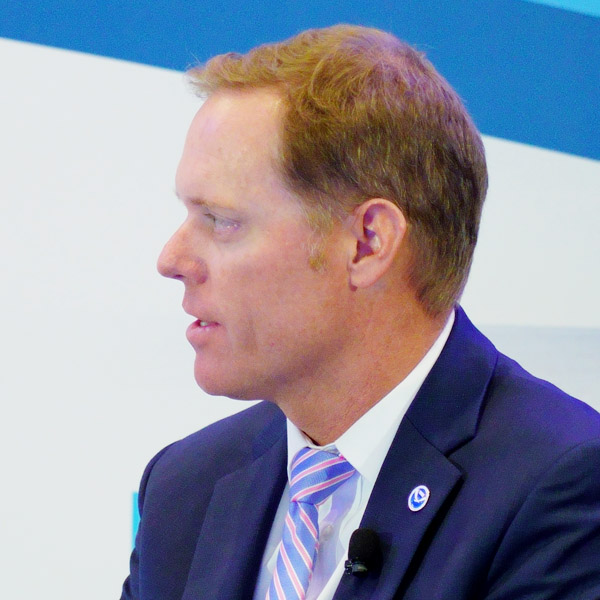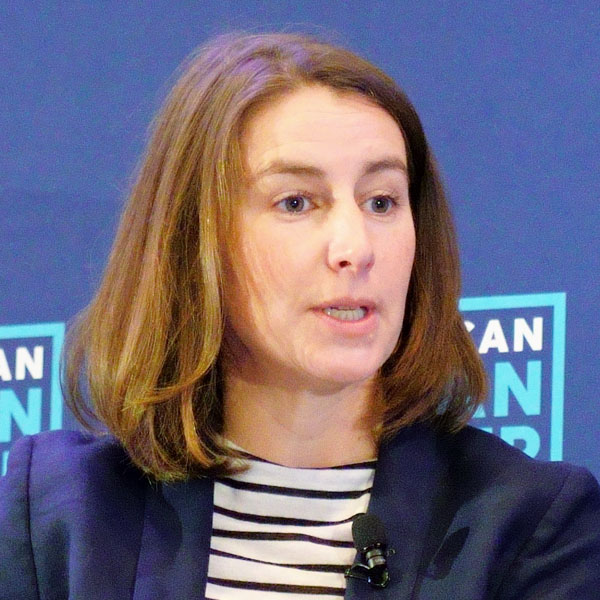ATLANTIC CITY, N.J. — The friction between the fishing and offshore wind industries was a recurring topic at Offshore WINDPOWER 2024, where multiple discussions examined approaches that have sought to smooth the relationship.
One panel featured representatives of the two sectors along the southern New England coast.
Moderator Ed Anthes-Washburn of Coast Line Transfers said the work of all four panelists intersected in New Bedford. He is a former director of the city’s port, which calls itself America’s most lucrative fishing center but also has become an important offshore wind hub.
“Over the course of our tenure, I think we sort of stumbled into a really good model that we think really needs to be told,” he said. “It’s a great model of really early engagement, understanding the science and commercial opportunities for commercial fishermen.”
In summary, the relationship eases some of fishers’ economic concerns by putting them to work at offshore wind construction sites as supporting players.
These crews, with their extensive knowledge of local waters and the local maritime industries, are a great asset for solving or preventing problems.
“It’s added value, because you have that local knowledge,” said Crista Bank, fisheries liaison for Vineyard Wind. “I can’t talk about how many times our scout vessel in Massachusetts was really key in our cable installation going off without a hitch, and it wouldn’t have happened without that.”
Fishers can fish legally only so many days a year, and the extra income when their boats otherwise would be idle helps keep the fleet and workforce intact, panelists said.
There are benefits on land, too. Panelist Michael Quinn of Shoreline Offshore is a second-generation scallop fisherman but also operates two onshore facilities with about 50 employees. He saw the increasing activity around offshore wind around 2018 and decided to be part of it.
Several years later, his company fabricated a fender for the first crew transfer vessel at the Vineyard Wind work zone two weeks before cable work started. It is a small example, but one that can be replicated extensively.
“In a lot of ways, local content is just content when you’re local, but engaging and knowing who that person is that can actually deliver something on time and quickly and high quality is really important,” Anthes-Washburn said. “And there’s a lot of folks in a lot of these ports up and down the East Coast that can be helpful.”
New London, Conn., fisherman Mike Theiler said in the 2000s he visited a Northern Ireland port that had suffered the collapse of its fishing industry and diversified to other marine commerce in response.
Theiler still fishes, but now also is managing director of Quintham, a software company focusing on fishing safety.
“I lived through a fisheries disaster with the collapse of lobster stock in southern New England and the die-off of ’99 and it was a great opportunity for these fishermen to diversify,” he said.
Bank said Vineyard has paid for 179 fishermen to go through the safety training or boat captain certification needed to operate at an offshore wind project and has paid for any safety upgrades needed to lift their boats above the standards for fishing vessels.
Forty-five separate local vessels have worked on the projects, and they are not in competition, Bank said: They are put on a rotating schedule and paid equally.
Vineyard Wind’s high-profile blade failure this summer gave an example of the economic and personal relationship that had formed between the developer and the local fishers.
“When we all of a sudden needed some extra vessels on the waterfront to help to pick up some marine debris, our fishing vessels were the first ones out there,” Bank said. “Then I had phone calls from multiple other fishermen with different-sized vessels, like, ‘What do you need? Can I get out there? How can I help?’”
“Crista is so well known on the waterfront,” Anthes-Washburn said.
Then he turned to the elephant not in the room: Not every fisher has such a good relationship with offshore wind. Some are fighting it tooth and nail.
Anthes-Washburn asked the panel: “Are fishermen who support offshore wind seen as traitors by other fishermen?”
“That’s definitely something that you have to deal with,” Quinn said. “I would say I got a lot more flack in the beginning, before I was getting contracted out there and people working, because it’s easy to put something down that you’ve never seen happen.”
He added: “I want to have a seat at the table and say, ‘How can we do this the right way together, and come up with a process that works for both sides, where we can all benefit long term?’”
Gulf of Maine
Another panel looked farther north in New England, to the Gulf of Maine, where a lengthy process culminated in exclusion of key fishing areas for offshore wind leasing consideration, including Lobster Management Area 1.
James A. Morris Jr., a NOAA ecologist, said the agency did something it had considered previously in other regions: It drew a model excluding every area where one stakeholder or another objected to wind power development.
The entire Gulf map was colored red when they were done.
“The point is that ultimately there will always be compromise, there’ll always be some, because there is no space in our coastal ocean that is free of conflict,” he said. “We’ve looked — that really doesn’t exist.”
Close engagement, however, drills down on the motives and thinking behind opposition to wind turbines at particular sites. It can range from nowhere-no how-never to “just not where we fish,” Morris said.
“Those are challenging conversations, and they’re not conversations that can happen fast. There’s a certain level of relationships that can be built, and trust has to be built.”
Celina Cunningham, deputy director of the Maine Governor’s Energy Office, said those conversations and relationships can produce results.
“There are plenty of people in the Gulf of Maine region who will never support offshore wind,” she said. “That’s fine; we expect that. There are a lot of people who do. And what I have learned from our work is that when you take the time and you share the data and you have those conversations, you can actually, I think, get some respect for the process.”
Morris said a lingering problem is creating an accurate model of impacts to present to the fishing industry and other maritime stakeholders — regulatory and scientific agencies are using past data, hindcasting instead of forecasting.
“We do not have available, accurate, defensible, high-quality data for future ocean conditions,” he said. “We have to invest more into future-casting of ocean conditions, ocean characteristics.”





